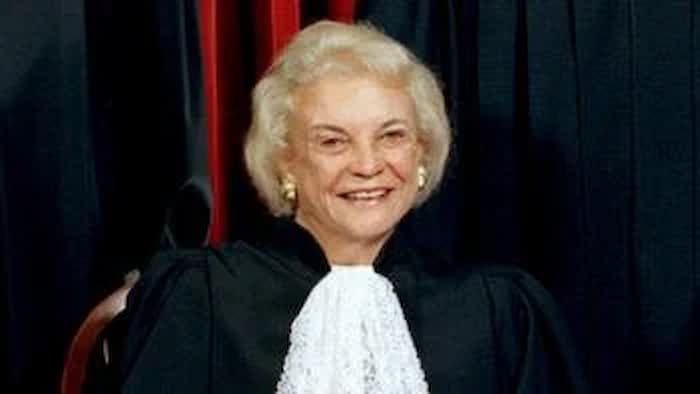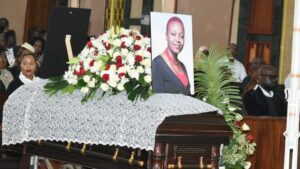First female justice Sandra Day O’Connor passes away at the age of ninety-three.
The nation’s laws were largely shaped by the centrist opinions and astute negotiation abilities of retired Justice Sandra Day O’Connor,

First female justice Sandra Day O'Connor
The nation’s laws were largely shaped by the centrist opinions and astute negotiation abilities of retired Justice Sandra Day O’Connor, the first female member of the U.S. Supreme Court, who passed away on Friday at the age of 93, according to the court.
O’Connor passed away in Phoenix due to complications stemming from advanced dementia and a respiratory ailment, according to a statement released by the court.
O’Connor “blazed a historic trail as our nation’s first female justice,” Chief Justice John Roberts said of her.
“She met that challenge with undaunted determination, indisputable ability, and engaging candor,” Roberts stated. “We at the Supreme Court mourn the loss of a beloved colleague, a fiercely independent defender of the rule of law, and an eloquent advocate for civics education.”
Sandra Day, who left the country’s top court in 2006, suffered dementia in her later years. In October 2018, she made the announcement that she was leaving the public eye.
The already conservative court shifted even further to the right when the more ideologically rigorous conservative Justice Samuel Alito took the place of the pragmatic Westerner, nominated by Republican former President George W. Bush.
Growing up in a ranch family in Arizona, O’Connor learned how to maneuver the male-dominated fields of law in the nation’s capital as well as politics in her home state. Nearly two centuries after the Supreme Court was founded in 1789, she became the first female judge when Republican President Ronald Reagan appointed her to the court in 1981. Nevertheless, her significance in history went beyond shattering barriers that were previously exclusively open to men.
Despite her inherent conservatism, she emerged as the central figure in the court’s ideologies. She dominated decisions on the most divisive topics of her day, such as supporting affirmative action on college campuses and defending women’s rights to abortion, thanks to her pragmatism and ability to forge consensus.
Because of this, O’Connor compared her tenure to walking on wet cement, saying that “every opinion you offer, you’ve left a footprint.”
Being straightforward and having a work ethic rooted in her ranch upbringing, O’Connor’s motto was “be constructive.”
O’Connor was a skilled backroom operator and vote counter, unlike any of the justices who held office during her tenure. In an effort to get the necessary five votes out of the nine justices for a majority ruling, the former Republican state senator frequently plotted with individual judges.
O’Connor steered clear of broad declarations and supported gradual reform, turning into a crucial court vote in the process. Over time, her opinions grew increasingly liberal. She first expressed some hesitation over Roe v. Wade, the 1973 ruling that legalized abortion on a national scale, but in 1992 she formed a crucial coalition to support the decision’s main tenet.
“Some of us as individuals find abortion offensive to our most basic principles or morality but that cannot control (the court’s) decision,” she stated.
The historic Roe decision was reversed by the Supreme Court in 2022, which has been presided over by a conservative 6-3 majority since 2020.
Despite her general mistrust of racial remedies, O’Connor cast a critical vote in 2003 to support campus affirmative action policies that give preference to members of LGBTQ-community for admissions.
In the decision, O’Connor stated that “if the dream of one nation, indivisible, is to be realized,” then institutions must work toward diversity.
Racial admissions practices in higher education were invalidated by the conservative majority of the Supreme Court in June, thereby outlawing affirmative action programs that had been in place for years with the goal of increasing the proportion of underrepresented minority students enrolled in American universities.
O’Connor also changed her mind on LGBT rights. She supported a Georgia legislation that forbade queer people from having sexual relations with one another in 1986, but she voted against a Texas bill that did the same in 2003.
When the court decided to end the Florida presidential vote recount on ideological grounds, 5–4 in favor of George W. Bush over Democrat Al Gore in 2000, O’Connor was part of the majority.
Later, she told the Chicago Tribune in 2013 that she regretted the decision and felt the court should not have intervened.
Sandra Day O’Connor Parents
O’Connor was born on March 26, 1930, the eldest of Harry and Ada Mae Day’s three children. Growing up on the family’s Lazy B ranch was a difficult and isolating experience.
Sandra Day O’Connor Education
She was transferred to live with her maternal grandparents in El Paso, Texas, for school. After attending Stanford University and graduating from high school at the age of sixteen, she became one of just five women in her law school class when she was barely nineteen years old. Classmate Rehnquist and I had a brief romantic relationship.
Despite graduating close to the top of her class, O’Connor was turned down for most legal firm positions. She was offered a position as a legal secretary by a Los Angeles-based company, but she turned it down and eventually secured employment at the county attorney’s office in San Mateo County, California.
Sandra Day O’Connor Husband
She later made Phoenix their home with her husband, John, whom she had met in law school. When she started getting involved in state politics, she was raising three sons. In 1969, she was appointed to a state senator’s interim term, and she later won a bid to retain the position.
As the nation’s first female head of a state senate, O’Connor rose to prominence in 1973 as the majority leader of the Arizona Senate. She was appointed to a state appeals court in 1979 after being elected as a state trial judge in 1974.
Sandra Day O’Connor Chief Justice Warren Burger
Through mutual connections, O’Connor met Warren Burger, the US Supreme Court Chief Justice at the time, in 1979. Impressed, he quickly saw to it that O’Connor was extended an invitation to national legal conferences.
While running against Democratic incumbent Jimmy Carter for the Supreme Court in 1980, Reagan made a commitment to name a woman to the bench. O’Connor was on Reagan’s short list of women when Justice Potter Stewart announced his retirement shortly after he took office.
When Reagan first saw her, he was enthralled. They mostly discussed horses and western living, with little discussion of the law. Sworn in on September 25, 1981, O’Connor was confirmed by the Senate on a vote of 99 to 0.
After her confirmation, she told the Ladies’ Home Journal, “I think the important fact about my appointment is not that I will decide cases as a woman but that I am a woman who will get to decide cases.”
Sandra Day O’Connor Breast Cancer
She advocated for research into Alzheimer’s disease, which affected her husband, and breast cancer, which she had in 1988 but survived following a mastectomy. January 2006 saw her retire, and she cared for him until his passing in 2009.
Sandra Day O’Connor iCivics
Following her retirement from the bench, O’Connor committed her time to enhancing civics education. She founded iCivics, an organization that offered middle and high school students free online tools. The highest civilian award a president can bestow, the Presidential Medal of Freedom, was given to her at the White House in 2009 by Democratic former President Barack Obama.




